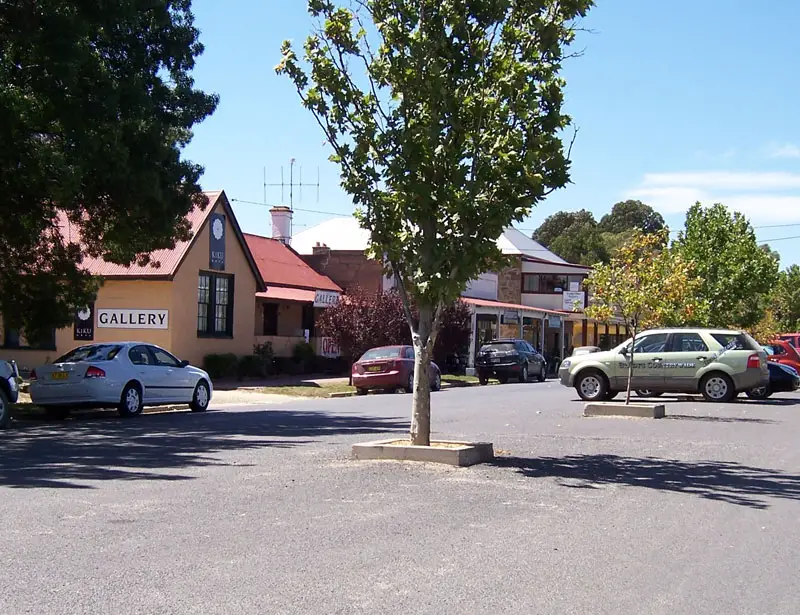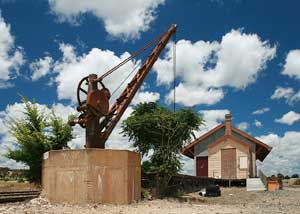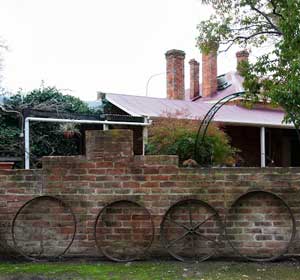
Bungendore
Bungendore (36 km east): a small town frozen somewhat in time, Bungendore offers numerous specialty shops and old stone, brick and timber heritage buildings, providing an evocative glimpse of 19th century life in rural Australia. It has become a major tourist centre in recent years, popular with visitors from Canberra.
Many of the town’s important buildings were constructed in the 1840s. Bungendore has many heritage listed buildings include the Railway Station (1884), used in the filming of The Year My Voice Broke and the Mick Jagger version of Ned Kelly; ‘Turalla’ (c.1833-35); ‘Carwoola’ (c.1849). Established in 1885, The Carrington Inn has enjoyed a colourful and adventurous life. Initially a coaching inn for travellers on the Cobb & Co route the Carrington has in its century and a half existence, also been a general store and a private residence.
The town offers numerous specialty shops and old stone, brick and timber heritage buildings, providing an evocative glimpse of 19th-century life in rural Australia. Discover art, craft and antique shops in the Bungendore Village Square and browse the Bungendore Wood Works Gallery for sculpture, craft and furniture.
If food and wine take your fancy, Bungendore has two wineries for you to visit – sample the fine local wines at Lark Hill and Lerida Estate, both of which are also restaurants. If you crave the great outdoors, there is an abundance of natural attractions further afield in the Queanbeyan area – don’t miss Googong Foreshores or Monga National Park. There’s a small but charming selection of accommodation in town, and many more places to stay in the surrounding area.
Bungendore is close to Gibraltar Hill, and to the Great Dividing Range (Butmaroo Range) some 10 km to the East, not far from the Butmaroo Homestead.
Bungendore railway station is served by three daily NSW TrainLink Xplorer services in each direction operating between Sydney and Canberra.
Prior to European settlement, the area was occupied by the Ngarigo people. The first Europeans in the vicinity were members of the exploratory party of Dr Charles Throsby in 1820, who, along with Hamilton Hume, also originally explored the Braidwood area. In 1824, explorer Allan Cunningham passed through Bungendore. A year later, the first European settlers arrived. The mail service to Bungendore was introduced in 1837, enhancing the importance of the village and contributing to the proclamation of Bungendore as a “town” in the same year.
By 1848, 30 people populated the seven buildings in the town of Bungendore[citation needed]. When the railway arrived on 4 March 1885, the town began to grow more quickly. New buildings appeared rapidly, such as churches, the courthouse/police station, two schools and the post office.
The first post office was built in Bungendore in 1840, an Anglican church c 1843, and the Bungendore Inn in 1847. The latter became a Cobb and Co staging post. By 1851, the population was 63. The 1850s saw at least two other hotels established. A flour mill was built in 1861, St Mary’s Roman Catholic Church and two denominational schools in 1862, the courthouse in 1864 and a public school in 1868. In 1866, local crops grown were recorded as being wheat, oats, barley and potatoes. Tourism is now a major contributor to the economy.
The town remained a railhead from 1885 until the line reached Queanbeyan in 1887. Partly because of the coming railway, the 1880s proved a boom period for the town and the population increased from 270 in 1881, to 700 by 1885. By then, Queanbeyan was emerging as the major town in the area.
In 1894, gold was discovered at Bywong. In 1901, Lake George and Bungendore were proposed as sites for the nation’s capital city. This did not eventuate, as the drawcard of Lake George failed to impress the visiting Commissioners of the time. By 1909 rabbit trapping had become an extremely valuable industry in the area around Bungendore. The town itself had a rabbit-freezing plant that employed 14 workers and over 250 trappers. In the year ending July 31, 1909, over 1.5 million rabbits were frozen at Bungendore. In 2008, following some community concerns the Capital Wind Farm was established north of Bungendore along Lake George.








